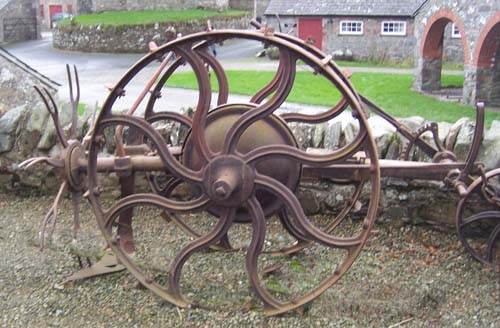|
|
 Cultivation
of the potatoes in Ireland began in the mid fifteen hundreds when
it was introduced from South America by Sir
Walter Raleigh, described among other things as 'Ireland's first
potato farmer', Raleigh is said to have planted Ireland's first
potatoes at Killua
Castle in county Westmeath. Cultivation
of the potatoes in Ireland began in the mid fifteen hundreds when
it was introduced from South America by Sir
Walter Raleigh, described among other things as 'Ireland's first
potato farmer', Raleigh is said to have planted Ireland's first
potatoes at Killua
Castle in county Westmeath.
The potato was well suited to the Irish climate,
within a comparatively short period of time potatoes were grown
the length and breadth of the country. So abundant were the crops
that many of the population, the poor in particular came to depend
on them as their main food source. It is said that the the early
1800's agricultural labourer's consumed upwards of 12 lbs of potatoes
a day and little else.
This dependence was to have a catastrophic
effect on Ireland's population when in 1845 potato blight appeared
in Ireland. The census of 1841 recorded the population as 8,175,124
by 1851 this had fallen during the Irish
famine by death and emigration to 6,552,385.
Up until the industrial revolution all the
potato crop would have been dug by spade, the potato digger illustrated
above was to change all this, at least for the more prosperous farmers
and estate owners. The machine was pulled by two horses, the large
cast iron wheels drove the spinner at the back via a bevel gear,
the knife or share seen on the ground in the illustration was set
to cut through the ground at the bottom of the potato drill, this
depth was set by the small wheel seen on the right of the picture,
the spinner threw the soil and potatoes to the left of the machine
looking from behind, the spinner could be engaged or disengaged
at will by a simple dog clutch. People then gathered the exposed
potato's into wicker baskets (Potato baskets) when a basket was
full it was transferred into a hessian bag, which was then loaded
into a cart to be taken to the farm yard.
|
|
In latter years
farmers often fitted length of rubber tube and often teats
from milking machine clusters to the double tines of the spinner
wheel, to stop the metal fingers damaging the potatoes. In
this era too when school was compulsory many children were
kept at home to help gather the crop.
Today potatoes are gathered by machines
which scoop up the entire drill and separate the potatoes
out using wire screens, similar to a garden riddle.
|
|